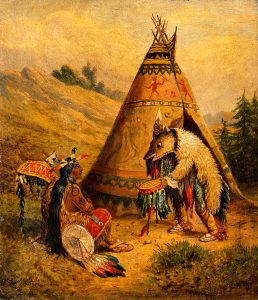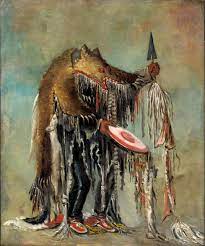NATIVE AMERICAN HISTORY: A TALE OF MEDICINE
Last November came and went, and unbeknownst for many people, so did Native American Heritage Month. Although Native American Day had been unofficially celebrated since 1916, it wasn’t until 1990 that President George H.W. Bush passed a resolution declaring November Native American Heritage Month. Every year since then, each president has passed resolutions doing the same. The original proclamation calls “upon Federal, State and local Governments, groups and organizations and the people of the United States to observe [it] with appropriate programs, ceremonies and activities” [1]. President Obama’s address stated, “Let us celebrate the traditions, languages, and stories of Native Americans and ensure their rich histories and contributions can thrive with each passing generation” [2]. What better way to commemorate Native American contribution and history than by briefly exploring their role and contribution to the medical field.
To begin to understand Native Americans’ role in medicine, it is important to have a brief understanding of their own history in relation to health and medicine. It is astonishing to see historically the early advancements many tribes had in the medical field. Those advancements are even more amazing when compared to the European knowledge of medicine that prevailed at the time.
Native American healing traditions vary by tribe, often reaching back thousands of years. There seems to be a consensus among most tribes that health is “an expression of the spirit and a continual process of staying strong spiritually, mentally, and physically.” Mourning Dove of the Salish tribe, the first female Native American author to publish a book, wrote, “Everything on the earth has a purpose, every disease an herb to cure it, and every person a mission. This is the Indian theory of existence.” This idea this is echoic of the holistic view of medicine that is taught throughout many modern U.S. medical schools and even originates centuries ago with Hippocrates (the father of the Hippocratic Oath) [3].
Many herbs used by Native Americans have provided derivatives for many modern medications. One statistic says that “more than 120 drugs prescribed by physicians today were first made from plant extracts, and 75 percent of these were derived from examining plants used in traditional indigenous medicine” [4]. Some examples are listed below with their scientific name and purpose:
Cascara sagrada (Rhanimus purshiana): laxative
Dogbane (Apocynum androsaemifolium): to treat edema secondary to renal and cardiac failure; an oral contraceptive
Foxglove (Digitalis purpurea): to treat heart failure (main ingredient in digitalis)
Guaiacum (Guaiac officinale): antitussive (Robutussin); guaiac-based fecal occult blood test
Salicin (Salix nigra): metabolizes to salicylic acid, main ingredient in aspirin
Sassafras (Sassafras albidum): antihelmintic, anticoagulant, antidiarrheal, and antiemetic
All tribes had herbs for certain ailments, and some tribes were advanced in their tools and procedures. They had syringes made from hollow bones. They performed arthrocentesis, surgical and wound debridement, orthopedic techniques such as traction and countertraction, thoracentesis, and others, including trephination—a type of brain surgery performed successfully in the Inca and Mayan civilizations. Not only were some of these foreign to early European doctors but the Native methods were more humane. Before the mid-1800s, European doctors lacked effective anesthetics when many tribes had these. Some non-Native physicians relied on knocking patients out by striking them in the jaw. Others used ether, alcohol, or opium, which at times required such high dosages that they often killed the patients [5]. The Natives of the Southwest and northern Mexico used peyote to eliminate the pain of lacerations, fractures, snakebites, etc. Peyote was so effective that US army surgeons adopted its use as a painkiller. Jamestown weed (Datura stramonium L.), more commonly known as jimson weed, was used externally and internally as an anesthetic by the natives of the Virginia area. The roots were ground into a poultice for external use and ingested for more systemic results. These practices were also adopted by early colonial physicians due to its effectiveness [4].
Pharmacology is a key part of historic and modern medicine but would be foundationless without physicians. Two early influential Native American physicians played a key part in medicine today. The earliest is Susan La Flesche Picotte (1865-1915) from the Omaha tribe. Not only was she the first female Native American physician in the US but also among the first Native Americans to graduate from medical school. PBS recently produced a documentary on her entitled Medicine Woman. She graduated the top of her class from the Women’s Medical College of Pennsylvania in 1889. She returned to the Omaha reservation where her yearly salary was merely $500, 10 times less than army or navy doctors were receiving. Despite poor compensation, she treated both white and Native patients and devoted her career to promoting change and improving conditions on reservations. She was an enduring advocate for alcoholism prevention on the reservations [6]. Dr. Picotte’s legacy lives on in the hospital she founded, which now carries her name, and in the lives of female physicians, Native and non-native.
Another influential physician was Carlos Montezuma (1866-1923). He was kidnapped from his Yavapai family in Arizona and sold to a photographer named Carlos Gentile for 30 pieces of silver. Upon adopting him as a son, Gentile changed Carlos Montezuma’s name from his Yavapai birth name Wassaja. After a stint in photography and stage acting, they settled in Chicago. It was here that his official education began and ended. He graduated from Chicago Medical College in 1889, becoming the first Native man to earn an MD degree.
Eventually, upon returning to Arizona as the doctor for the Carlise Indian School Pop Warner football team, he reconnected with his family, culture, and heritage. Having previously seen government bureaucracy inhibit and persecute Native Americans, he felt a passion for improving their conditions. When land developers approached the U.S. government to have the Yavapai moved to the Salt Water Pima reservation he advocated the tribe’s cause in Washington D.C. In time, his advocacy pushed the government to allow the Yavapai to remain on their original reservation just 15 miles east of Phoenix. He founded his own newspaper and called it Wassaja after his birth name, which fittingly means “beaconing.” Until his death from TB in 1923, he forcefully argued against Natives being drafted in WWI, at a time when they lacked citizenship, and other basic rights, including their right to vote [7].
Whether the modern field of medicine recognizes it or not, Native Americans are intricately intertwined into the history of medicine. It may be their view on health philosophy or their extensive contributions to pharmacology. It may be a woman born in a tepee who became a trailblazer for women and Natives everywhere. It may be a man kidnapped from his family and culture who eventually returned home to become a beacon for a suppressed and often misunderstood and maligned people. Whichever way it might be, medicine has always been a pillar of Native American culture and will continue to be long after Native American Heritage Month. Native American contributions are a part of the heritage of medicine, and a great debt of gratitude is owed for those contributions.
Hits: 3







